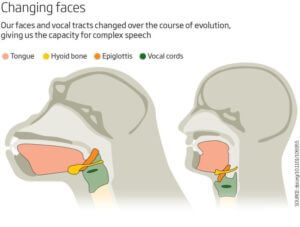How and when did we first become able to speak? A new analysis of our DNA reveals key evolutionary changes that reshaped our faces and larynxes, and which may have set the stage for complex speech. The alterations were not major mutations in our genes. Instead, they were tweaks in the activity of existing genes that we shared with our immediate ancestors. These changes in gene activity seem to have given us flat faces, by retracting the protruding chins of our ape ancestors. They also resculpted the larynx and moved it further down in the throat, allowing our ancestors to make sounds with greater subtleties.
…

Liran Carmel of the Hebrew University of Jerusalem and his colleagues examined DNA from two modern-day people and four humans who lived within the last 50,000 years. They also looked at extinct hominins: two Neanderthals and a Denisovan. Finally, they looked at genetic material from six chimpanzees and data from public databases supplied by living people.
…
“Neanderthals most likely had brains capable of learning and executing the complex manoeuvres involved in talking, but their speech would not have been as clear and comprehensible as ours, perhaps accounting in part for their extinction,” says Philip Lieberman of Brown University in Rhode Island. “I think Neanderthals could talk, but more indistinctly than us.”
The GLP aggregated and excerpted this blog/article to reflect the diversity of news, opinion, and analysis. Read full, original post: It only takes a few gene tweaks to make a human voice































